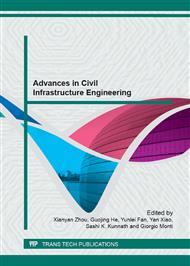p.1120
p.1127
p.1133
p.1137
p.1142
p.1148
p.1155
p.1162
p.1168
A NetSLab Based Hybrid Testing Program for Composite Frame Structures with Buckling Restrained Braces
Abstract:
A networked structural laboratory system NetSLab has been developed for shared use of laboratory facilities and computing resources. The NetSLab consists of a network based communication platform and a series of hybrid testing programs. In this paper, a hybrid testing program for simulating seismic responses of composite frame structures with buckling restrained braces has been developed. The entire frame structure is simplified as a multi-degree-of-freedom model and only the relationship between story shear force and story drift is considered. The hybrid testing program consists of three types of modules, namely control center, physical tester, virtual tester. Control center organizes testing procedure and handles numerical integration. Physical tester and virtual tester generate restoring forces of substructures using actual testing equipment or numerical simulation. The substructure tested can be any continuous multi-story or a single brace taken from the entire frame structure. A serial port communication method is utilized to transfer request and feedback data between physical tester and the control computer of Popwil electro-hydraulic servo system. A series of virtual and physical hybrid tests of composite frame structures with buckling restrained braces under earthquake excitations were carried out. The results validated the reliability of the testing program.
Info:
Periodical:
Pages:
1142-1147
Citation:
Online since:
January 2013
Authors:
Price:
Сopyright:
© 2013 Trans Tech Publications Ltd. All Rights Reserved
Share:
Citation:


